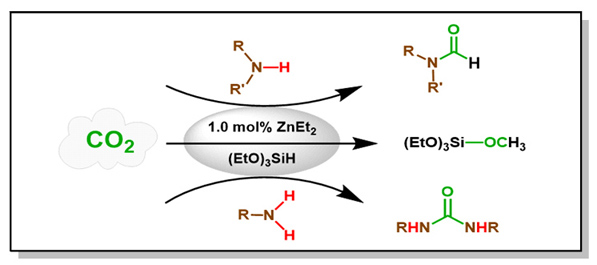摘要/Abstract

CO2的固定和转化具有重要研究意义,特别是采用廉价且良好生物相容性的金属催化剂将其转化为有用的有机化合物.本工作报道采用商品化ZnEt2(1.0 mol%)可促进CO2的硅氢化反应生成甲氧基硅醚,以及CO2为C1合成子的有机胺甲酰化或脲化反应生成酰胺或脲类化合物.在1.0 mol% ZnEt2存在下,CO2和(EtO)3SiH发生硅氢化反应,一锅选择性还原为甲氧基硅醚(CH3OSi(OEt)3).考察了反应条件的影响,在1.0 MPa CO2起始压力下,90℃反应7 h,甲氧基硅醚的产率达到约90%.当上述反应体系中存在有机胺时,则发生了CO2为C1合成子的的有机胺甲酰化或脲化反应.当采用二级有机胺为底物时,反应生成酰胺类产物;当一级有机胺为底物时,反应主要生成脲类产物.考察了反应底物取代基的影响,含脂肪基和芳香基的二级有机胺均可发生甲酰化反应,芳香基的对位含给电子取代基时明显有利于该甲酰化反应.含脂肪基和芳香基的一级有机胺均可发生脲化反应,芳香基对位取代基的电子性质对脲化反应的影响规律不如在甲酰化反应中的明显.
关键词: 二乙基锌, 二氧化碳转化, 硅氢化反应, 酰胺, 脲
Fixation and transformation of CO2 are of the great importance, especially the conversion of CO2 into valuable organic compounds catalyzed by the cheap and biocompatible metal catalysts. Zinc is an abundant, biocompatible and environmentally friendly element. ZnEt2 is commercial available, and has been widely used as reducing or transmetalation agent in hydrocarboxylation of unsaturated hydrocarbons with CO2. In these reactions, ZnEt2 is generally used in stoichiometric amount or excess amout. This manuscript reports the hydrosilylation of CO2 into methoxysilane promoted by a catalytic amount of ZnEt2 (1.0 mol%), the ZnEt2 promoted formylation or urealation of amines with CO2 as a one-carbon (C1) building block is also described. The hydrosilylation of CO2 into methoxysilane (CH3OSi(OEt)3) with (EtO)3SiH as a hydrosilylation reagent is affected by CO2 pressure, ZnEt2 amount, reaction temperature and reaction time. Under the reaction conditions of 1.0 MPa CO2 (the initial CO2 pressure) and 1.0 mol% ZnEt2, the yield of methoxysilane is up to ca. 90% after 7 h at 90℃, and no solvent is used for this reaction. In the presence of organic amine, the reaction gives formamide or urea instead of methoxysilane. Under 1.5 MPa CO2, 1.0 mol% ZnEt2, 2.4 equiv. (EtO)3SiH and 100℃, a series of secondary amines, both the aromatic ones and the aliphatic ones, can be formylated into formamides. In the formylation of N-methylanilines with different substituents at para-position, the isolated yields of the formylation products are in the order of OMe≈Me>H>F>Cl≈Br>CF3>NO2, indicating the electron-donating group at the para-position of the N-methylanilines is benefit for the formylation reaction. When primary amines are used as the substrates, the reactions prefer to produce urea derivatives under the same reaction conditions. In the urealation reaction, the electronic effect is not as significant as that in the formylation reaction.
Key words: ZnEt2, carbon dioxidetransformation, hydrosilylation, formamides, ureas
PDF全文下载地址:
点我下载PDF
